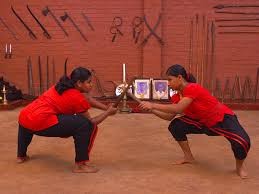The word “vinyasa” has different meaning but when we talk about the physical practice of yoga we refer to as a dynamic style of yoga characterized by stringing postures together so that you move from one to another, seamlessly, using your breath as a catalyst.
Vinyasa as we know it today can also be called “vinyasa flow” or “flow yoga” and they originate by the style of Ashtanga Vinyasa, the method developed by Sri K. Pattabhi Jois in Mysore in the 1940’s. However, in the modern style of vinyasa a variety of postures is offered and two classes are seldom the same and that is the main difference with the Ashtanga method, which has the same sequence every time.
The term Vinyasa derives from the Sanskrit “nyasa”, meaning “to place,” and vi, meaning “in a special way.”. This indicates the consciousness that we bring to each movement in each moment. Vinyasa is therefore a breath syncronized practice that helps us develop a more balanced body and a more steady mind. Vinyasa practice generates heat and can add a cardiovascular component not always present in other forms of postural practice.
During your Vinyasa TTC you will be practicing different classes with a variety of different focuses (strength, balance, flexibility, inversions etc…). Chances are you will be sweating and maybe struggling, but hopefully you will also learn to laugh and have fun about it!
Also, you will be learning about sequencing and alignment during the “art of teaching” classes and you will practice the correct type of breathing needed for this style of yoga (this breathing is known as Ujjayi breath).
Category
- Teacher's Training
- 500 Hours YTTC
Styles
- Ashtanga Yoga
- Vinyasa Yoga
Skill level
- Beginner
- Intermediate
- Advance
Food Type
- Vegetarian
Meals
- Breakfast
- Lunch
- Dinner
Retreat For
- Family Friendly
- Solo Traveller
- For Couples
Stay Not Available
Meet the instructors

Hari Pawali
I am Hari Pawali and welcome to Shree Hari Yoga School. I founded the school with the goal of providing affordable high-quality training in yoga and the healing arts, with students of all paths and levels. I set forth to create an inclusive community of students and teachers where all feel welcomed and where I could share the knowledge and experien... Read More
Hari Pawali

Mayank Patel
Designation: Yoga Professional with 7 years of rich work experience in teaching Yoga to groups and individuals in India and Cambodia. Teaching Experience: Expertise in the areas of Teaching multilevel yoga classes ,stress management ,diet management, Himalayan Sound Healing , Depression counselling , Life Management Through Bhagwad Geeta .... Read More
Mayank Patel

VSR Bhaskar
Designation: My self I am VSR Bhaskar ,born in an orthodox Vedic family which is deeply rooted in yogic tradition for many generations. I am spiritually inclined from child hood. I am a traveller and truth seeker . golden icon Teaching Experience: By the blessings of 11 enlightened masters,I have done research on 7 ancient paths of yoga to... Read More
VSR Bhaskar
Program
Day 1
-
07:00 am - 08:00 am Pranayama, meditation or cleansing (Kriya) 08:00 am - 09:30 am Asana practice & last week practicum 09:30 am - 10:30 am Silent breakfast 10:30 am - 11:30 am Art of Teaching 11:30 am - 12:30 pm Anatomy & physiology 12:30 pm - 02:00 pm Lunch 02:00 pm - 03:00 pm Self Study 03:00 pm - 04:00 pm Philosophy 04:00 pm - 05:30 pm Asana practice & last week practicum 05:30 pm - 06:00 pm Karma Yoga 06:00 pm - 07:00 pm Meditation/Learn how to chant your mantras & understand mudras 07:00 pm - 08:00 pm Dinner 08:00 pm - 05:00 am Bed Time
Mantras & Mudras
-
Mantras are considered as an important part of Vinyasa Yoga. When you recite mantras, the energy channels of the body open up, and you become more reception to the universe. It also aids one to focus the mind on the yoga practice. When you recite mantras, your stored emotions are released and you get the full benefits of the asanas.
Mudras are nothing but gestures, which you make with your hands and fingers mostly. There are nerves that pass through the fingertips, and each one is connected to a specific organ. When you press the same, you are actually providing therapeutic healing to those body parts




